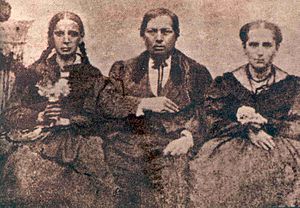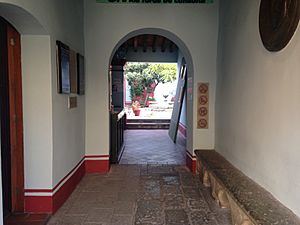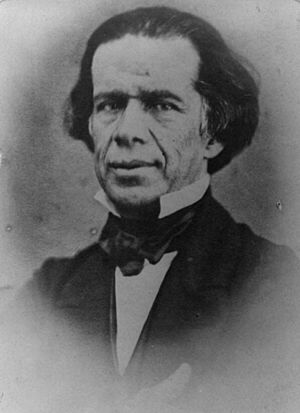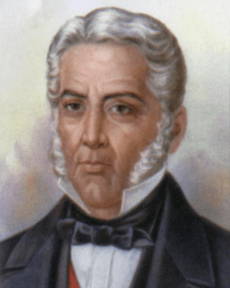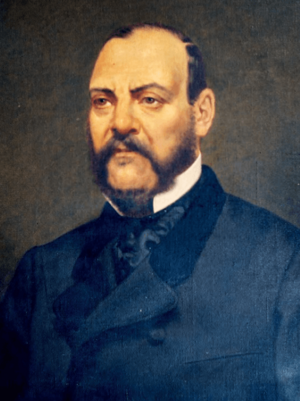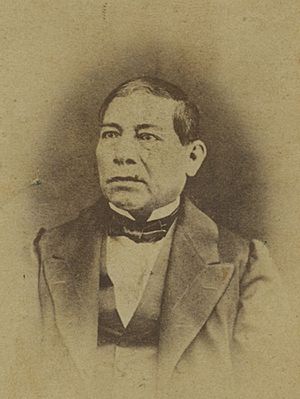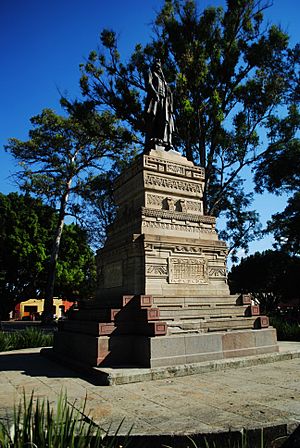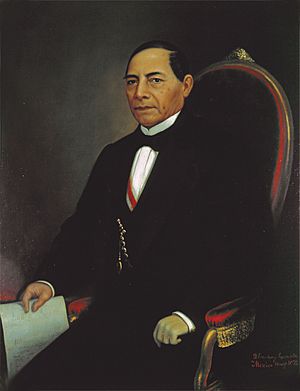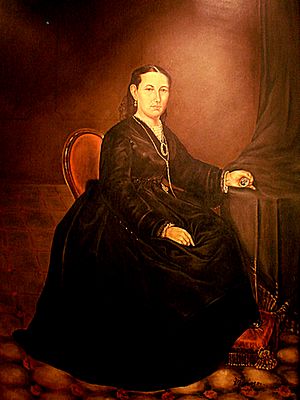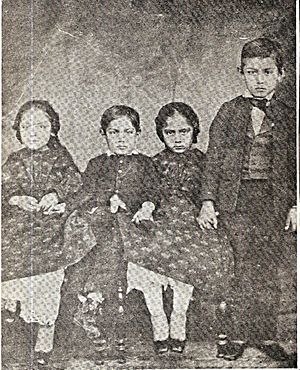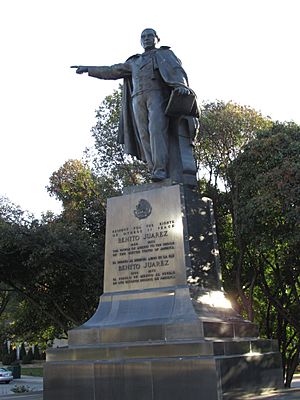Benito Juárez facts for kids
Quick facts for kids
The Most Excellent
Benito Juárez
|
|
|---|---|
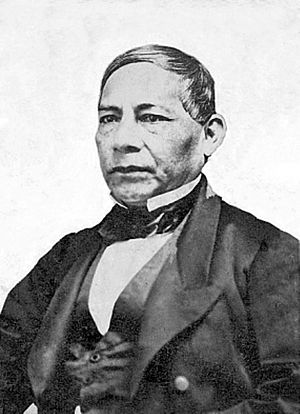
Benito Juárez, c. 1872
|
|
| 26th President of México | |
| In office 15 January 1858 – 18 July 1872 |
|
| Preceded by | Ignacio Comonfort |
| Succeeded by | Sebastián Lerdo de Tejada |
| President of the Supreme Court | |
| In office 11 December 1857 – 15 January 1858 |
|
| Preceded by | Luis de la Rosa Oteiza |
| Succeeded by | José Ignacio Pavón |
| Secretary of the Interior of Mexico | |
| In office 3 November 1857 – 11 December 1857 |
|
| President | Ignacio Comonfort |
| Preceded by | José María Cortés |
| Succeeded by | José María Cortés |
| Governor of Oaxaca | |
| In office 10 January 1856 – 3 November 1857 |
|
| Preceded by | José María García |
| Succeeded by | José María Díaz |
| In office 2 October 1847 – 12 August 1852 |
|
| Preceded by | Francisco Ortiz Zárate |
| Succeeded by | Lope San Germán |
| Secretary of Public Education of Mexico | |
| In office 6 October 1855 – 9 December 1855 |
|
| President | Juan Álvarez |
| Preceded by | José María Durán |
| Succeeded by | Ramón Isaac Alcaraz |
| Personal details | |
| Born |
Benito Pablo Juárez García
21 March 1806 San Pablo Guelatao, Oaxaca, New Spain |
| Died | 18 July 1872 (aged 66) Mexico City, Mexico |
| Resting place | Panteón de San Fernando |
| Nationality | Mexican |
| Political party | Liberal Party |
| Spouse |
Margarita Maza
(m. 1843; died 1871) |
| Alma mater | Institute of Sciences and Arts of Oaxaca |
| Profession | Lawyer, judge, politician |
| Signature |  |
Benito Pablo Juárez García (born March 21, 1806 – died July 18, 1872) was a very important Mexican leader. He was a liberal politician and a lawyer. He became the 26th president of Mexico in 1858 and stayed in office until he died in 1872.
Benito Juárez was a Zapotec person, which means he was one of the native people of Mexico. He was the first indigenous president of Mexico. Many people remember him as the most important Mexican president of the 1800s.
Juárez was born in Oaxaca to a poor family and became an orphan when he was very young. His uncle took care of him. At age 12, he moved to Oaxaca City and worked as a house helper. A kind Franciscan helped him get into a seminary (a school for priests). He later studied law and became involved in liberal politics.
After becoming a judge, he married Margarita Maza. She came from a well-known family. Juárez became famous after the leader Antonio López de Santa Anna was removed from power. He helped create "La Reforma", which were new liberal laws. These laws led to the Constitution of 1857.
When President Ignacio Comonfort resigned, Juárez became president because he was the head of the Supreme Court. He led the Mexican liberals against the conservatives in a war. He also fought against the French invasion.
Juárez believed in liberalism and Mexican nationalism. He stayed president until he died in 1872. He stood up against Maximilian I, who was made emperor by the French. After being elected president in 1861, he kept his term during the French invasion. He was re-elected in 1867 and 1871. He led Mexico during a time called the Restored Republic.
Juárez is seen as a hero of Mexican nationalism. He wanted Mexico to be like the United States, not Europe. His ideas included civil liberties (freedoms for people), equality before the law, and keeping the government separate from the Church and the army. He also wanted a stronger federal government. Many Mexicans saw his time as president as a "second fight for independence."
After he died, the city of Oaxaca added "de Juárez" to its name to honor him. Many other places are named after him too. His birthday, March 21, is a national holiday in Mexico.
Contents
Early Life and Education
Benito Juárez was born in a small adobe house in San Pablo Guelatao, Oaxaca. This area is now called the Sierra Juárez. His parents, Brígida García and Marcelino Juárez, were Zapotec farmers. He had two older sisters, Josefa and Rosa. Both his parents died when he was three years old. His grandparents also died soon after. Benito was then raised by his uncle, Bernardino Juárez. He described his parents as "Indians from the primitive race of the country."
He worked in cornfields and as a shepherd until he was 12. His sister had moved to Oaxaca City for work. That year, he also moved to the city to go to school. He got a job as a house helper for Antonio Maza, where his sister worked as a cook. At that time, he only spoke Zapotec.
A kind Franciscan friar named Antonio Salanueva helped Juárez. Salanueva was impressed by Benito's intelligence and wish to learn. He helped Benito get into the city's seminary to train as a priest. Benito studied Latin and finished his high school studies. But he soon realized he did not want to be a priest.
So, Juárez began studying law at the Institute of Sciences and Arts. This school was a center for liberal ideas in Oaxaca. He graduated with a law degree in 1834. Before graduating, Juárez was elected to the Oaxaca city council in 1831. After working as a lawyer for several years, he became a civil judge in 1841.
Political Journey
Juárez started his political career in his home state of Oaxaca. He eventually became the state governor. In 1853, he had to leave Mexico and live in the U.S. because he disagreed with General Antonio López de Santa Anna. While in the U.S., he made important friends with other Mexican liberals.
He became well-known after Santa Anna was removed from power. Juárez helped write new laws known as La Reforma. These laws were very liberal. Conservatives in Mexico did not like these changes. This led to President Ignacio Comonfort resigning. Because Juárez was the head of the Supreme Court, he became president.
A civil war started between the liberals and conservatives. The liberals won in 1860. Juárez was elected president in 1861. But then, conservatives allied with France. France invaded Mexico in 1862 and made Maximilian von Habsburg the emperor.
Even though liberals were divided, Juárez bravely fought against the foreign invasion. He became a symbol of Mexican nationalism. After the French were defeated in 1867, liberals started arguing among themselves again. Juárez wanted to make the presidency and central government stronger. His death in 1872 ended this period of Mexican politics.
Early Career in Oaxaca
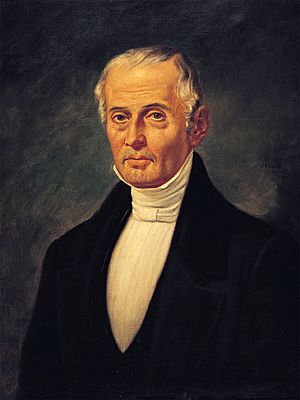
Juárez's time in Oaxaca politics was very important for his future. He developed his liberal ideas at the Institute of Arts and Science. He was able to rise in Oaxaca politics because there wasn't a strong group of powerful families controlling everything. This allowed new people like him to enter politics. He learned how to build political support and how politics worked.
Juárez became a lawyer in 1834. He often took cases for indigenous villagers. For example, people from Loxicha, Oaxaca, hired him to complain about a priest. He didn't win the case and was even put in jail. This experience made him want to fight against special privileges for certain groups. Juárez and other liberals believed in equality before the law. This was important because, after Mexico's independence, the Catholic Church and the army still had special legal rights.
He served as a civil judge in 1841. He then joined the Oaxaca state government, led by liberal governor Antonio León. Juárez became a prosecutor and was elected to the state legislature in 1845. He was later elected to the federal legislature. There, he supported Valentín Gómez Farías, who wanted to limit the power of the Catholic Church.
When Antonio López de Santa Anna became president again in 1847, Juárez returned to Oaxaca. He was elected governor of Oaxaca and served from 1847 to 1852. As governor, Juárez supported Mexico during the Mexican–American War. He refused Santa Anna's request to gather more troops because he knew the war was lost. He also disliked Santa Anna's corrupt rule. This led to Juárez being sent away to New Orleans in 1853.
Time in New Orleans Exile
Like many Mexican liberals, Juárez saw the U.S. as a good example for Mexico's future. Conservatives, however, preferred European models. When Santa Anna returned to power in 1853, many liberals, including Juárez, went to live in the U.S. In New Orleans, Juárez worked making cigars. His wife stayed in Mexico with their children. She was helped by other liberals.
Juárez spent about a year and a half in New Orleans (1853–55). This time was important for him and other exiles. He met Melchor Ocampo, a strong opponent of the Church. The exiles planned to return to Mexico and remove Santa Anna from power. In 1854, Juárez helped write the liberals' Plan of Ayutla. This plan called for Santa Anna to be removed and a new constitution to be written. Santa Anna resigned in 1855 due to growing opposition.
Juárez's time in New Orleans also connected him with Cuban exiles, like Pedro Santacicilia. Santacilia later married Juárez's oldest daughter. These connections were important for the Mexican liberal cause. They helped send weapons and support to the liberals during the War of the Reform.
Liberal Reforms (1855–1857)
After Santa Anna resigned, Juárez returned to Mexico. He joined the "pure" (puro) liberals. They formed a temporary government under General Juan Álvarez. This period is known as La Reforma, or Liberal Reform. Juárez became the Minister of Justice. During this time, he wrote the law named after him, the Juárez Law. This law said that all citizens were equal before the law. It also limited the special privileges of the Catholic Church and the Mexican army. President Álvarez signed this law in 1855.
The Reform laws reduced the traditional power of the military and the Catholic Church. The Lerdo law forced the sale of Church lands and lands owned by indigenous communities. The Juárez Law was later included in the Mexican Constitution of 1857. These laws aimed to create a modern society and economy like that of the United States. Juárez did not directly write the constitution because he was back in Oaxaca, serving as governor again.
The Constitution of 1857 was officially announced in February. The next president, Ignacio Comonfort, made Juárez the Minister of Government in November. Juárez was also elected President of the Supreme Court of Justice. This position meant he would become president if the current president left office.
War of the Reform (1858–1860)
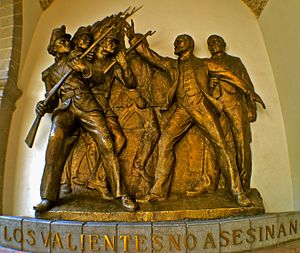
Conservatives did not accept the new constitution. They tried to overturn it. Led by General Félix María Zuloaga, conservatives wanted to cancel the constitution. They issued the Plan of Tacubaya in December 1857. President Ignacio Comonfort, a moderate liberal, did not fully support the constitution either. He signed the conservatives' plan, which called for a new constitution and gave him special powers. Juárez and other liberal leaders were arrested.
However, the conservatives wanted more. Zuloaga demanded Comonfort's resignation in January 1858. Comonfort then freed all prisoners, including Juárez, and resigned. The conservatives then declared Zuloaga as president.
According to the 1857 Constitution, the President of the Supreme Court became the temporary President of Mexico. So, when Comonfort resigned, Juárez became president on January 15, 1858. He led the liberals in the Reform War (1858–60). During this war, Mexico had two governments: the liberals under Juárez and the conservatives under Zuloaga.
The conservatives controlled Mexico City. So, Juárez and his government moved first to Querétaro and then to Veracruz. They used the money from customs taxes in Veracruz to fund their government. Juárez arrived in Veracruz in May 1858. His wife and children were there to meet him.
Juárez stayed in Veracruz for many months. In March 1859, conservative General Miguel Miramón attacked the port. In April, Juárez met with Robert Milligan McLane, a U.S. diplomat. The U.S. wanted a route across Mexico for trade. Juárez needed allies against the conservatives. So, he signed the McLane–Ocampo Treaty in December 1859. This treaty would have given the U.S. special rights across the Isthmus of Tehuantepec. However, the U.S. Senate did not approve the treaty. Even without the treaty, Juárez's government received help from the U.S. This help allowed the liberals to win against the conservatives. Juárez's government defended Veracruz twice in 1860. They recaptured Mexico City on January 1, 1861.
In July 1859, Juárez issued a law that stopped the Catholic Church from owning property in Mexico. The Church and the army supported the conservatives. The liberals had support from some states and from the U.S. government.
At first, Juárez's government was weak. Conservatives like Félix María Zuloaga and Leonardo Márquez tried to regain power. Juárez asked Congress for emergency powers. Liberal members of Congress refused, wanting to protect the constitution. But after conservatives killed liberal politicians Melchor Ocampo and Santos Degollado in 1861, liberals were very angry. Juárez then took "extreme measures" against the conservatives. Congress agreed to give Juárez more power to defeat the remaining conservative forces.
Constitutional Presidency (1861–1862)
After the liberals won the war, elections were held in March 1861. Juárez was elected president under the 1857 Constitution. He had two liberal rivals, Miguel Lerdo de Tejada and Jesús González Ortega. Many liberals supported Juárez. He won the 1861 election.
Even though the conservatives were defeated, they still caused trouble as guerrillas. In June, Melchor Ocampo and Santos Degollado were killed by conservative guerrillas. Juárez took strong action against them. General Leonardo Márquez refused to recognize Juárez as president. He was blamed for the murders.
Juárez's government also created the Rural Guard, or Rurales. This police force aimed to bring safety to the countryside, where banditry was common. Many former bandits became part of this force. This showed that Juárez was willing to take strong action to control the country.
Juárez's government also faced money problems. He decided to stop paying foreign debts. This made European countries angry. Britain, Spain, and France agreed to the Convention of London. They sent forces to Mexico in December 1861 to collect the debts. Spain and Britain soon left, but French Emperor Napoleon III wanted to overthrow Juárez. He wanted to create a Second Mexican Empire with the help of Mexican conservatives. This started the Second French intervention.
The American Civil War was happening in the U.S. at this time. But the U.S. government, led by President Abraham Lincoln, supported Juárez. The U.S. refused to join the European powers. They also did not recognize Maximilian as emperor. Congress gave Juárez special powers to deal with the crisis. He had to protect Mexico's independence and its form of government.
Juárez and the French Invasion (1862–67)
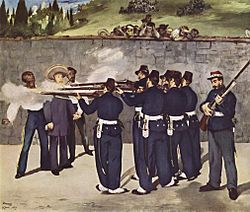
During the French invasion, Juárez became a symbol of Mexican nationalism. He led a united liberal republic against the foreign invaders. Mexican forces, led by Ignacio Zaragoza, won an important victory over the French on May 5, 1862. This battle is now celebrated as Cinco de Mayo. The French had to retreat for a year. But they came back in 1863 and captured Mexico City. Congress gave Juárez more special powers to handle the crisis.
Juárez left the capital and set up a government in different cities. He moved north, eventually reaching Chihuahua City near the U.S. border. There, he set up his cabinet.
Meanwhile, Mexican conservatives, with French support, created a new government. Maximilian von Habsburg, from Austria, accepted the offer to become Emperor of Mexico in 1863. He was backed by Napoleon III and Mexican conservatives.
Juárez's term as president was supposed to end in 1865. But he issued decrees to stay in office until elections could be held. He believed he had to continue leading the nation during this difficult time.
Maximilian offered Juárez a high position in his government, but Juárez refused. He would not accept a government put in place by foreigners. The U.S. government supported Juárez. They refused to recognize Maximilian and opposed the French invasion.
Juárez's wife, Margarita Maza, and their children lived in New York during the invasion. She met with U.S. President Abraham Lincoln, who treated her as Mexico's First Lady.
After the American Civil War ended, U.S. President Andrew Johnson demanded that the French leave Mexico. French troops began to leave in late 1866. Maximilian had also lost support from Mexican conservatives because of his liberal ideas. In 1867, Maximilian's forces were defeated. Maximilian was sentenced to death by a military court. Despite many pleas for him to be spared, Juárez refused. Maximilian was executed by firing squad on June 19, 1867.
Restored Republic (1867–1872)
The time after the French left, until 1876, is known as the Restored Republic. This period included the last years of Juárez's presidency and then the presidency of Sebastián Lerdo de Tejada.
After the French were defeated in 1867, other liberals began to object to Juárez staying in power without a new election. The liberals, who had united against the French, now had disagreements. Juárez wanted to change the Constitution to allow a third term and give more power to the president. His opponents saw this as him wanting to keep power for himself. The Constitution was designed to limit the power of the Church and army, and to give more power to the states. Juárez believed that the president needed more power to make the country stable.
The Restored Republic was a time of political unrest in Mexico. There were many rebellions. One challenge came from Antonio López de Santa Anna, who tried to return to Mexico from exile in 1867. Juárez's forces stopped him. Santa Anna was arrested and accused of being a traitor. Juárez wanted him to be sentenced to death, like Maximilian. But the military court sentenced Santa Anna to eight years of exile instead. Juárez later gave a general pardon to political opponents in 1870, but he specifically excluded Santa Anna. Santa Anna could only return to Mexico after Juárez died.
The War of the Reform and the French invasion had stopped the liberal reforms from being fully put into place. With the French defeated, it seemed like the time for change had come. Juárez had turned the fight against the French into a war for national freedom. This gave him a lot of political support.
In a controversial move, Juárez ran for re-election in 1871. His ally, Sebastián Lerdo de Tejada, had expected to become president. Juárez had already been criticized for staying in power. Lerdo resigned from Juárez's cabinet. Lerdo and Porfirio Díaz also ran for president. None of them won a majority of votes. Juárez got the most votes, but not enough to win outright. So, Congress had to decide. Congress chose Juárez because it was filled with his supporters. His opponents thought the election was unfair.
Díaz, who lost the election, started a rebellion called the Plan of la Noria against Juárez. Many political opponents did not want another civil war. Juárez kept the loyalty of important military leaders and was able to stop the rebellion. Juárez called Díaz a "latter-day Santa Anna," comparing him to their old enemy. Juárez used the rebellion as a chance to deal with rebellious groups in different states. After stopping Díaz's rebellion, Juárez tried again to change the constitution, but Congress blocked him.
Personal Life
On October 31, 1843, when he was in his late 30s, Juárez married Margarita Maza. Margarita was 20 years younger than him. Her father was from Genoa, and her mother was Mexican of Spanish descent. They were from a well-known family in Oaxaca. Margarita said of Juárez, "He is very homely, but very good." By marrying Margarita, Juárez gained social standing. Their marriage lasted until Margarita died from cancer in January 1871.
Juárez and Margarita had ten children together. Five of their children died young. Two of their sons died while they were in New York with their mother during the French invasion. Their only surviving son was Benito Juárez Maza [es], born in 1852. He became a diplomat and politician. Juárez's daughter Manuela married Cuban poet and activist Pedro Santacilia [es] in 1863.
Juárez also had other children before he married Margarita. He had a son named Tereso and a daughter named Susana. Susana was cared for by Juárez's friends after her mother died. Juárez and Margarita formally adopted Susana.
Juárez wrote a book for his children called "Apuntes para mis Hijos" ("Notes for my Children"). In this book, he briefly mentioned his indigenous background. Juárez believed that indigenous Mexicans should become full citizens, equal before the law.
Juárez was a high-ranking member of the Freemasons in Mexico. He was known for his strong belief in Masonic principles.
Juárez's health declined in 1870. His wife Margarita died in 1871. He suffered a heart attack in March 1872, the day before his birthday. He had another attack in July and a fatal one on July 17.
Freemasonry
Juárez became a Freemason in Oaxaca. He joined the Mexican National Rite and reached its highest level. This group had liberal and republican ideas. The Mexican National Rite wanted to be independent from foreign influence and promote Mexican nationalism.
Juárez was very dedicated to Freemasonry. Many Masonic groups honor him. His initiation ceremony was attended by important Masons, including Valentín Gómez Farías, who was President of Mexico. Juárez chose the symbolic name Guillermo Tell.
Death
Benito Juárez died of a heart attack on July 18, 1872, at age 66. He had been ill for two days. His death was announced with artillery fire. He was given a state funeral. He is buried in the Panteón de San Fernando in Mexico City, where other important Mexicans are buried.
When Juárez died, Porfirio Díaz's reasons for rebellion (like unfair elections) no longer existed. Juárez was succeeded by Sebastián Lerdo de Tejada, the head of the Supreme Court. Lerdo gave Díaz a pardon for his rebellion. Díaz later rebelled against Lerdo in 1876 and became president. Even though Díaz was Juárez's rival, he later helped shape how Juárez is remembered in history.
Legacy
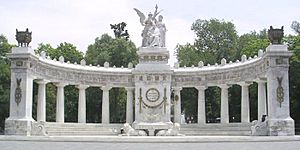
Today, Benito Juárez is remembered as a great reformer. He believed in democracy, equal rights for indigenous people, and reducing the power of the Catholic Church. He also strongly defended Mexico's independence. His time as leader is known as La Reforma del Norte (The Reform of the North).
This period brought big changes:
- Church lands were taken by the government.
- The army was put under civilian control.
- Communal lands of peasants were changed.
- The separation of church and state became law.
- Bishops, priests, and nuns lost some special rights. These changes were written in the "Juárez Law".
La Reforma was a victory for Mexico's liberal, federalist, and pro-capitalist forces. It replaced an older social system with a more market-driven one. But after Juárez died, Mexico faced political instability. This led to a return to strong, centralized rule under Porfirio Díaz. Díaz's rule (1876–1911) eventually led to the Mexican Revolution.
Honors and Recognition
Honors during his lifetime
- In 1866, Juárez was honored by the Military Order of the Loyal Legion of the United States (MOLLUS). This group usually honored U.S. officers, but Juárez was recognized for his help to the Union during the American Civil War.
- In 1867, the Congress of the Dominican Republic called Juárez the Benemérito de la América (Distinguished of America).
- In 1867, the government of Peru also honored Juárez.
Places named after him
- Many cities, towns, streets, and schools in Mexico are named after Benito Juárez. For example, the city once called El Paso del Norte is now Ciudad Juárez.
- The Mexico City International Airport is often called Aeropuerto Internacional Benito Juárez.
- The Benito Juárez Partido and the city of Benito Juárez, Buenos Aires in Argentina are named after him. This shows friendship between Argentina and Mexico.
- Benito Juarez Marg is a major road in South Delhi, India.
Mexican money
- Juárez is shown on the 20-peso banknote. He also appears on the new $500.00 (five hundred pesos) bills released in 2018.
Statues and monuments Benito Juárez has many statues and monuments outside of Mexico.
- There is a monument of Juárez in Washington, D.C., given by Mexico to the U.S.
- Sculptor Julian Martinez created two works for Juárez: a sculpture in Chicago and a bust in Houston.
- In New York City, there is a sculpture called Benito Juárez (2004) in Bryant Park.
In film and media
- The play Juárez and Maximilian was written by Franz Werfel in 1924.
- The 1939 American film Juárez starred Paul Muni as Juárez.
- Juárez has also been featured in TV shows like Death Valley Days and The Wild Wild West.
Other namesakes
- The Italian leader Benito Mussolini was named after Juárez.
- A school in Sofia, Bulgaria, and another in Warsaw, Poland, are named after Juárez.
- A species of Mexican snake, Geophis Juárezi, is named after him.
Juárez Complex National Palace In the National Palace in Mexico City, where Juárez lived, there is a small museum in his honor. It shows his furniture and personal items.
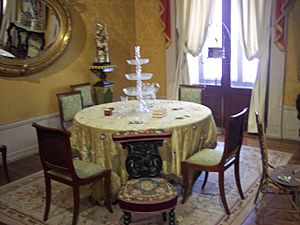 |
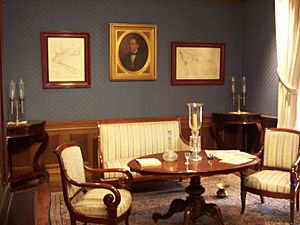 |
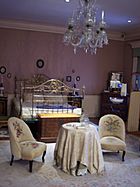 |
|---|
Famous Quotes
Juárez's most famous quote is: "Entre los individuos, como entre las naciones, el respeto al derecho ajeno es la paz". This means "Among individuals, as among nations, respect for the rights of others is peace." The bold part is on the coat of arms of Oaxaca. This quote shows Mexico's view on foreign relations.
Another important quote is: "La ley ha sido siempre mi espada y mi escudo", or "The law has always been my shield and my sword." This phrase is often seen in court buildings.
See also
 In Spanish: Benito Juárez para niños
In Spanish: Benito Juárez para niños
- List of heads of state of Mexico
- History of Mexico
- Liberalism in Mexico
- War of the Reform
- Reform laws
- History of Roman Catholicism in Mexico


